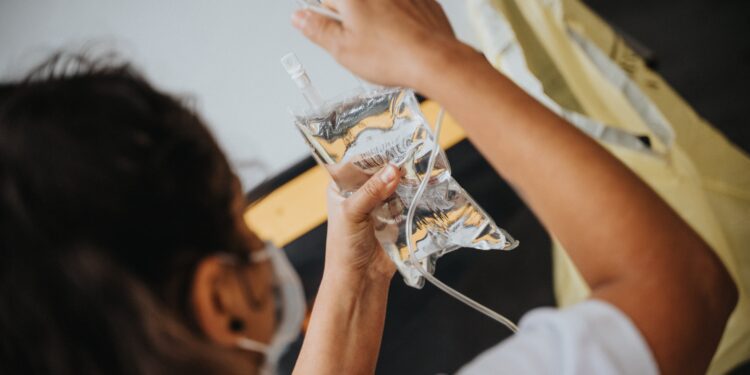Ketamine has made headlines lately for all the wrong reasons. Despite the negative coverage, ketamine is proven to treat depression. However, much of its efficacy and use in combination with other medication remains uncertain. So we ask:
Would ketamine, in combination with SSRIs, give us both an immediate and long-term treatment for depression?
We have a problem with current recommendations for depression treatment. Thirty-five percent of patients will not go into remission or get any relief at all from SSRIs and SNRIs. And even when it does work, it takes about six weeks to start having an effect. The prevailing theory was that serotonin, abbreviated 5-HT, was the satisfaction neurotransmitter; Just as dopamine has been considered the pleasure neurotransmitter. Using selective serotonin reuptake inhibitors like Prozac leaves serotonin in the synapses longer, and this action was thought to improve mood since it helps regulate sleep, cognition, and behavior in the central nervous system.
It is important here to address a concern of SSRI use. There have been studies showing that it might trigger suicidal ideation in some patients. However, a recent study in Sweden showed that the 30 days prior to SSRI treatment initiation was associated with the highest risk of suicidal behavior compared with the 30 days one year before SSRI initiation. The 30 days after initiation of treatment actually showed a reduced risk of suicidal behavior. This could indicate that some patients are only seeking treatment once their depression is so severe that they are having thoughts of suicide. This risk then declined with treatment. This occurred in both the young and old.
One study does not prove anything, but this research was excellently performed, and with suicide being the leading cause of death among ages 15 to 24 worldwide, it is important to keep in mind. But if serotonin was controlling our mood, we had a problem. The synaptic serotonin increase is almost immediate, while the elevation of mood takes many weeks. Why? If serotonin levels control our mood, why does it take so long? A recent study shows that our conclusion on what is triggering an improvement in mood may be wrong. In a study of escitalopram (Lexapro), a popular SSRI, it turns out that serotonin is also implicated in cytoskeletal rearrangements and long-term potentiation. These are important for learning and memory, something we call neuroplasticity.
Is depression the result of our brains being “stuck” in a certain mode, and the increased serotonin is helping us grow our way out of it? This neuroplastic theory of depression is gaining support, and it might explain another depression-related mystery.
Ketamine seems to be able to give substantial relief to some patients suffering from depression within an hour of administration. Ketamine exerts its activity on the brain through its actions on the N-methyl-D-aspartate (NMDA) glutamate receptor. NMDA receptors are linked to disorders like schizophrenia and psychosis. Glutamate is the major excitatory neurotransmitter in the brain, and the NMDA receptor is one of the most common glutamatergic receptors. The NMDA receptor also plays a key role in learning, memory, and mood regulation. Ketamine binds to a different site than glutamate on the NMDA receptor and works as a non-competitive antagonist. That means it blocks the function of the receptor without directly blocking glutamate binding. Unlike most medications, continued use of ketamine can increase its binding effectiveness.
The only form of ketamine currently approved for the treatment of depression in patients with treatment-resistant depression and major depressive disorder is Spravato (esketamine). Ketamine is usually produced as a racemic mixture, and esketamine is the left-handed enantiomer. Think of it as S-ketamine. Ketamine can cause feelings of dissociation, dizziness, and increased blood pressure at higher doses.
According to the National Institute of Health, it can be used at a dose of 1 to 1.5mg/kg IV, or 3 to 4mg IM, while the nasal spray with esketamine is 84mg twice per week for four weeks for MDD and there is a more complicated regimen for TRD. For some reason, when ketamine is used by IV infusion (ketamine), nasal spray (esketamine), or even an oral compounded capsule containing ketamine powder, there is a significant elevation of mood in many patients that can persist for up to six months. It is an immediate relief from depression. This action seems to be mediated by what is sometimes called synaptoplasticity. The dendrites of each neuron receive inputs from the axons of other neurons. These connections take place on what are called “spines” on the dendrites. These spines are thorn-like protrusions that seem to store necessary supplies necessary for nerve signal transmission, like calcium.
The researchers found that under control conditions, new dendritic spines occur 20-25% of the time, but when ketamine is present, these spines form about 50% of the time. This is a five-to-two-fold increase measured within four hours of ketamine administration and persists for up to twelve hours. This increase in synaptoplasticity could explain the fast action of ketamine. While the cytoskeletal changes stimulated by SSRIs would take longer. Would an optimum treatment for depression be a one-time dose of ketamine followed by initiation and continued treatment with SSRIs? Perhaps boosted by another dose of ketamine if progress slows before complete resolution?
If this approach proves viable, we could have an immediate and long-term treatment for these conditions that affect 8.9 million and 2.8 million Americans per year. Only further study can say, but since the economic cost of depression to the country is estimated at $136.5M , it might be a good investment to find out. All we have to do is stop stigmatizing potential treatments at the first sign of bad news.















